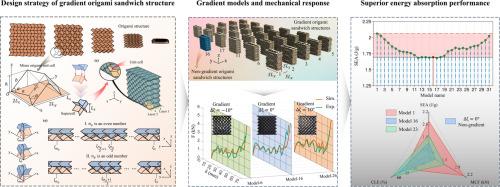轻型折纸三明治结构与梯度设计,以提高能量吸收能力
IF 6.6
1区 工程技术
Q1 ENGINEERING, CIVIL
引用次数: 0
摘要
折纸结构作为典型的机械超材料,由于其轻量化、高强度和可定制的机械性能而引起了广泛的关注,使其在航空航天、汽车工程和防护装备方面的应用具有很大的前景。然而,许多传统的折纸结构,特别是基于均匀镶嵌的折纸结构,由于其相对固定的折叠模式和有限的渐变变形能力,在机械可调性和适应性方面受到限制,限制了其更广泛的功能应用。为了克服这些限制,我们从天然材料的层次性和梯度性特征中汲取灵感,提出了一种可控梯度折纸三明治结构设计方法。这种方法将三浦折纸折叠模式与梯度设计原则相结合。通过有限元方法、3D打印物理模型实验和理论分析验证了梯度折纸三明治结构的力学性能。结果表明,大多数梯度结构优于均匀结构,其中比能吸收(SEA)和平均压缩力(MCF)的提高幅度最大,分别达到35%和41%。与非梯度结构相比,梯度的引入可以显著调节折纸夹层结构的内应力传播机制,重新配置折纸夹层结构的变形模式。此外,在三点弯曲试验中,梯度结构表现出更高的峰值力和更好的能量吸收能力。这些研究结果系统地强调了梯度设计对折纸夹层结构能量吸收和变形行为的影响,并得到了理论分析、数值模拟和实验验证的支持。本文章由计算机程序翻译,如有差异,请以英文原文为准。

Lightweight origami sandwich structures with gradient design for improved energy absorption capacity
Origami structures, as typical mechanical metamaterials, have garnered extensive attention due to their lightweight, high strength, and customizable mechanical properties, making them highly promising for applications in aerospace, automotive engineering, and protective equipment. However, many conventional origami structures, especially those based on uniform tessellation, face limitations in mechanical tunability and adaptability due to their relatively fixed folding patterns and limited capacity for graded deformation, which restrict their broader functional application. To overcome these limitations, we propose a controllable gradient origami sandwich structure design method, drawing inspiration from the hierarchical and gradient characteristics of natural materials. This approach integrates the Miura-origami folding pattern with gradient design principles. The mechanical properties of gradient origami sandwich structures are validated through finite element methods, experiments utilizing 3D printed physical models, and theoretical analysis. Results show that most gradient structures outperform their uniform counterparts, with the highest improvements in specific energy absorption (SEA) and mean compressive force (MCF) reaching 35 % and 41 %, respectively. The introduction of gradients can significantly modulate the internal stress propagation mechanisms and reconfigure the deformation modes of origami sandwich structures compared with non-gradient structure. Additionally, gradient structures exhibited higher peak forces and better energy absorption capabilities in three-point bending tests. These findings systematically highlight the influence of gradient design on the energy absorption and deformation behavior of origami sandwich structures, supported by theoretical analysis, numerical simulations, and experimental validation.
求助全文
通过发布文献求助,成功后即可免费获取论文全文。
去求助
来源期刊

Thin-Walled Structures
工程技术-工程:土木
CiteScore
9.60
自引率
20.30%
发文量
801
审稿时长
66 days
期刊介绍:
Thin-walled structures comprises an important and growing proportion of engineering construction with areas of application becoming increasingly diverse, ranging from aircraft, bridges, ships and oil rigs to storage vessels, industrial buildings and warehouses.
Many factors, including cost and weight economy, new materials and processes and the growth of powerful methods of analysis have contributed to this growth, and led to the need for a journal which concentrates specifically on structures in which problems arise due to the thinness of the walls. This field includes cold– formed sections, plate and shell structures, reinforced plastics structures and aluminium structures, and is of importance in many branches of engineering.
The primary criterion for consideration of papers in Thin–Walled Structures is that they must be concerned with thin–walled structures or the basic problems inherent in thin–walled structures. Provided this criterion is satisfied no restriction is placed on the type of construction, material or field of application. Papers on theory, experiment, design, etc., are published and it is expected that many papers will contain aspects of all three.
 求助内容:
求助内容: 应助结果提醒方式:
应助结果提醒方式:


